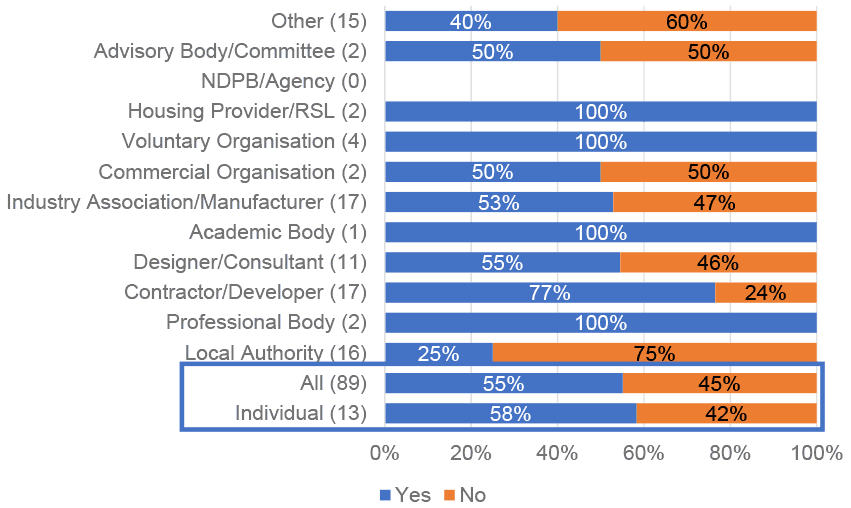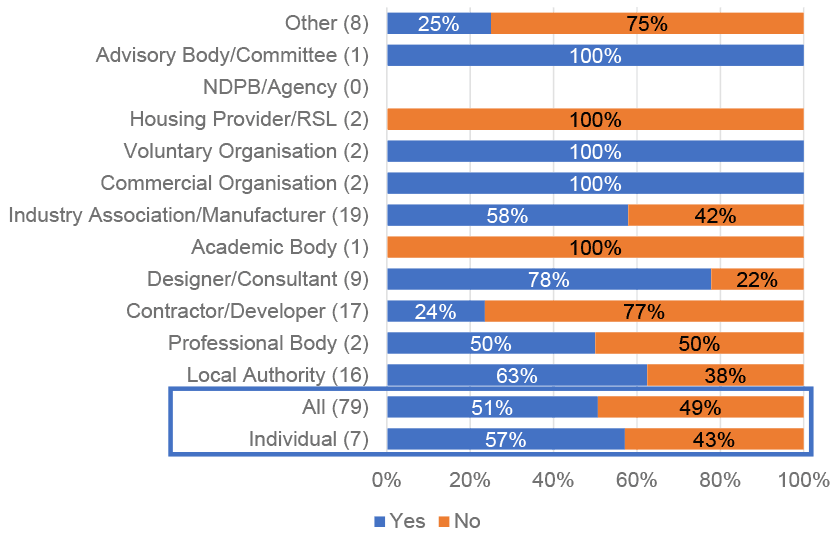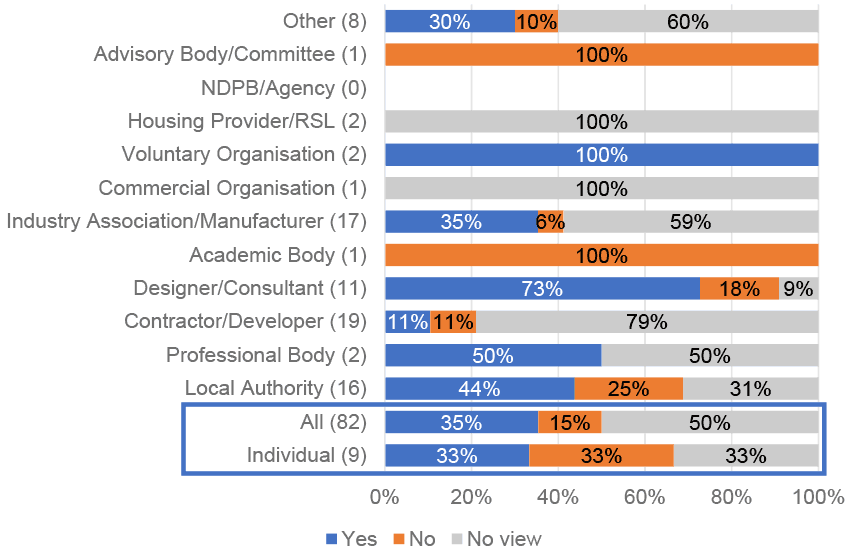Building regulations - proposed changes to energy standards, etc: consultation analysis
An analysis of the responses to the 2021 public consultation on a review of building standards relating to energy standards and associated topics, including ventilation, overheating and electric vehicle charging infrastructure.
7 Part 6 – Improving and demonstrating compliance
In late 2019, BSD commissioned a short research project to assist in understanding the issues that arise in the delivery of low energy buildings and how greater assurance of process could be delivered, focusing primarily on building fabric issues. The output of the project was not intended to be a guide for designers and contractors but to inform the later development of such a resource.
It is intended to now progress this agenda, extending scope to include the design, installation and commissioning of building services, in the context of the Compliance Plan approach. BSD are commissioning the development of a ‘compliance manual’ to support effective delivery of compliance with Section 6 (energy) in a format which would be compatible with the Compliance Plan approach and supporting core guidance.
7.1 Successful design or construction quality assurance schemes
7.1.1 Question 47
Do you have any experience of successful design or construction quality assurance regimes which you consider may be useful to consider in the context of the development of a Compliance Plan manual to support the effective delivery of compliance with section 6 (energy)?
Eighty-nine responses to this question were received and 62 responses to the accompanying open question. Three respondents provided an open response but did not answer the preceding open ‘yes/no’ question.

Base: 89 respondents (87 no response) NB Individual respondents are listed separately at the bottom for information - as they are included in organisation responses (per Section 2.3)
7.1.2 Analysis
Overall, responses were split fairly evenly with 55% stating they do have experience of such regimes and 45% stating they do not have experience (Figure 51).
Respondents gave details of processes for National House Building Council (NHBC), Passivhaus and the Structural Timber Association, alongside references to technical guidance documents. There was a general appreciation of the difficulties around assurance of compliance.
7.1.3 Designed versus as-built performance
Several respondents mentioned the gap between designed versus as-built performance. An Industry Association/manufacturer highlighted a perceived failure to introduce as built testing, suggesting that ignoring the performance gap (between designed and as built) risks the net zero ambition. A Local Authority called for robust action to ensure as-built compliance with section 6 regulations, and a review of the resources & training available to Buildings Standards Officers to deal with section 6 compliance. A Professional body called for the Certification of Design for Section 6 Energy to become mandatory. An Industry Association/manufacturer perceived a need for developing construction details to show ‘good practice’ for all aspects of Building Regulations (e.g., acoustic, fire, etc.). Another highlights that compliance is extremely difficult, and that supervision of outputs is even more challenging due to time pressures, weather and variances in materials delivered.
7.1.4 Competent individuals
Several respondents raised this theme, noting the following:
- Most of the sector is unregulated and that any “Compliance Plan” introduced should be underpinned by the use of properly qualified individuals and businesses.
- An independent professional who can reinforce checks and verify compliance would be helpful.
- Competent Persons Schemes currently run in England and Wales could be used effectively in Scotland.
- A scheme in Canada where anyone submitting a warrant for buildings over a certain size (including dwellings), is required to sit exams relating to the various sections of the regulations.
Respondents gave examples of technical guidance, standards, and publications which they use or consider would inform a Compliance Plan Manual.
7.1.5 Other guidance
Other guidance, organisations and standards referenced by respondents:
- Building Research Establishment's Environmental Assessment Method (BREEAM).
- The NABERS scheme (NABERS a system for rating the energy efficiency of office buildings used across the UK.
- Local Authority Building Control.
- Construction Quality Assurance 1.
- RIAS Certification of Design for Part 6.
- Association for Environment Conscious Building) (AECB).
Passivhaus was mentioned by 14 respondents who identified several beneficial features of the Passivhaus process, with some respondents going on to state that Passivhaus has the longest track record of delivering homes that meet their design performance as well as the standards of energy efficiency needed to deliver net zero buildings.
A total of 12 respondents referred to NHBC. Seven respondents mentioned NHBC sharing compliance issues on a monthly basis with developers.
7.2 Comments on the compliance themes identified
7.2.1 Question 48
Do you have any comments on the compliance themes identified (i.e., informed design, risk assessment, calculation, communication, competence, commissioning, quality assurance, performance testing and use of data) and any other actions you consider would be useful in supporting improved compliance with requirements for energy and emission performance?
Seventy-nine responses to the closed question were received and 53 responses to the accompanying open question. Eleven respondents provided an open response but did not answer the preceding open ‘yes/no’ question.

Base: 79 respondents (97 no response) NB Individual respondents are listed separately at the bottom for information – as they are included in organisation responses (per Section 2.3)
7.2.2 Analysis
Just over half (51%) of respondents stated that they had comments to make (Figure 52). There was a total of forty responses to the open question. The proposals were welcomed by a broad spectrum of respondents, some respondents caveated their agreement with a need for flexibility or a requirement for third party assessment.
7.2.3 Competence
Almost a quarter of respondents leaving comments expressed a view on the competence requirements for compliance plan managers and other professionals in assessment or construction roles.
Several respondents suggested that the ‘coordinating individual’ role is aligned with the role played by a Passivhaus Designer/ Consultant with support from the Passivhaus Certifier. Respondents went on to repeat a campaign response – “Passivhaus achieves third party verification with a Certification scheme. Critically the Certifier is independent of the designer and contractor”.
A few respondents noted that currently there is no requirement for individuals who carry out energy assessments or produce compliance reports to be members of an approved organisation, and there was support for assessors being required to be members of professional organisations. One respondent went on to state that membership of professional organisations would ensure assessors are subject to quality assurance in terms of reports and CPD and ensure assessments are completed to a high standard.
A few respondents welcomed the implementation of greater checks through the design and verification process but cautioned that this will require additional resource. A Local Authority stated “there is not sufficient resource or funding within building standards services to take these initiatives forward”; while an Industry association/manufacturer highlighted that the additional cost is not expected to be considerable, but it comes at a time when materials and labour costs are already extremely volatile. Another Industry association/manufacturer warned of a need to ensure designers and installers are not exposed to excessive burdens that hamper project progress.
7.2.4 Designed v as-built performance
Communication was highlighted as a key issue by several respondents in addressing the design v as-built performance gap.
A few respondents suggested that standards could be driven up by increasing use of thermal imaging equipment, with one suggesting this will have a similar effect to airtightness testing.
A few respondents highlighted the importance of recording key construction details in the effort to avoid performance gaps.
7.2.5 Data
A few respondents had views on how data collected during the assessment process could be best used.
A Commercial organisation suggested that data collected should be incorporated into a “building passport”. The respondent went on to state that an information pack of the products and methods of installation would not only benefit verifiers, but also benefit occupants, future generations and the Government’s own information on the types and quality of the housing stock.
A Designer/consultant suggested that the assessment process could introduce the ability to extract powerful data on construction projects being undertaken and how the feedback and lessons learned can then be applied to future updates and revisions to the building standards and how it can apply to the construction industry in general.
7.3 Improving compliance with energy standards – topics of interest
7.3.1 Question 49
Are there particular aspects to building design and construction which you consider should be prioritised as part of the development of a detailed compliance plan manual for section 6 (energy)?
Eighty-two responses to this question were received with 52 responses to the accompanying open question. Nine respondents provided an open response but did not answer the preceding open ‘yes/no’ question.

Base: 82 respondents (94 no response) NB Individual respondents are listed separately at the bottom for information - as they are included in organisation responses (per Section 2.3)
7.3.2 Analysis
Half of respondents stated they have ‘no view’ (Figure 53). Only just over a third (35%) stated that there are particular aspects that should be considered.
Respondents gave a range of views regarding priorities for the compliance plan manual. The main themes are:
- Many respondents (including a campaign response) suggested that all aspects are equally important and that none should be prioritised.
- Several respondents showed support for prioritising verification of products.
- Carbon and embodied carbon were mentioned by several respondents including a campaign response): they highlighted a need to prioritise regulations which detail compliance with minimum standards for embodied energy and whole life carbon and suggested the inclusion of a compliance check for embodied carbon and the submission of Environmental Product Declarations. A campaign response stated all aspects of the consultation address operational carbon, but that a more important issue is embodied carbon.
- Guidance for occupiers was stated as a priority by several respondents: specific areas respondents stated should be covered by guidance include commissioning, operation, and maintenance schedules to inform future activities including replacement of plant.
- Airtightness testing was directly referenced as a priority by a few respondents.
Alongside the themes above respondents also asked for further detail regarding implementation in practice and highlighted a requirement for measures not to be overly burdensome on the design, build and commissioning process.
7.4 Further comments on improving compliance of building work
7.4.1 Question 50
We welcome any other comments you may wish to make on the topic of improving compliance of building work with the provisions within section 6 (energy) of the Technical Handbooks to better align designed and as-built performance.
7.4.2 Analysis
Forty-five responses to this open question were received.
Respondents gave a range of comments, some choosing to use this question to express broad agreement with the proposals. The main focus for comments was on competence and skills requirements for various roles involved in the compliance process, from Compliance Manager to tradespeople. Respondents also re-iterated their responses to previous questions. Generally, responses were supportive although there were concerns around resourcing any changes.
7.4.3 Passivhaus
Passivhaus was cited in several responses either as an alternative means of compliance or as a baseline for performance for new build projects and together with AECB Retrofit /EnerPHit standard as a baseline for performance for whole house/building retrofit projects.
7.4.4 Compliance Plan Manager
A few respondents stress the importance of competence for individuals holding the role of Compliance Plan Manager. One respondent suggested a single point of contact to fulfil the “over role” working with a number of competent people each with responsibility for ensuring compliance within their respective discipline; each of these individuals being chartered members of a relevant professional body.
A few respondents urged caution that the role does not impose additional cost and burden on the industry, a Local Authority warned that contractors may try to perform this role themselves if perceived costs are too high.
The importance of independence in the role was highlighted by a Designer/consultant who stated that the Compliance Plan Manager should either be an independent clerk of works who is audited by an approved body or Building Control should retain responsibility for ensuring that buildings are constructed in accordance with the approved plans.
7.4.5 The role of “The Relevant Person”
A campaign response highlighted the perceived problems below with the current model of the Relevant Person applying for Completion from the Verifier. The response stated that often the Relevant Person is the commissioning party; they may not have adequate technical knowledge. Verifiers do not have the resources to make increased numbers of site visits, and the extent of their duty of ‘reasonable enquiry’ cannot be adequately met. (The increased use of remote verification inspections (RVI’s) could improve this situation to an extent.)
7.4.6 Verifiers
A few respondents – including a campaign response – expressed concern that the proposals will impact on the verifier in terms of time and costs associated with pre and post building warrant work. Suggestions were made of methods to relieve the burden on Verifiers.
7.4.7 Construction, Compliance and Notification Plan (CCNP)
A few respondents had similar concerns around CCNPs, stating they are not robust, or extensive enough, and that CCNP stages are not always notified in a timely manner and roles/responsibilities need to be tightened up.
Other areas mentioned by individual respondents, largely re-iterating responses to previous questions include information for occupiers, enforcement, airtightness testing, modular construction, embodied carbon measurement and thermal imaging.
Contact
Email: buildingstandards@gov.scot
There is a problem
Thanks for your feedback